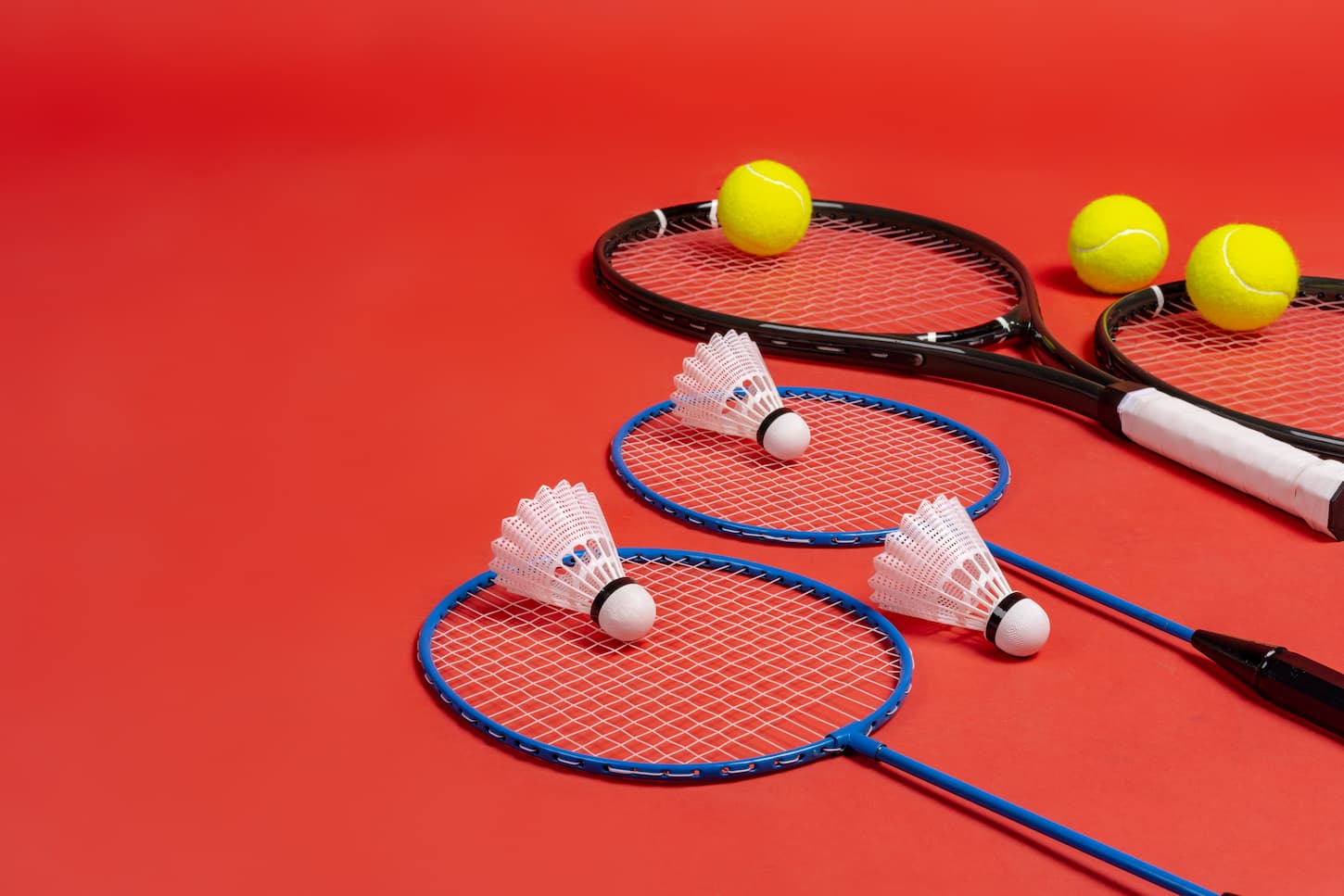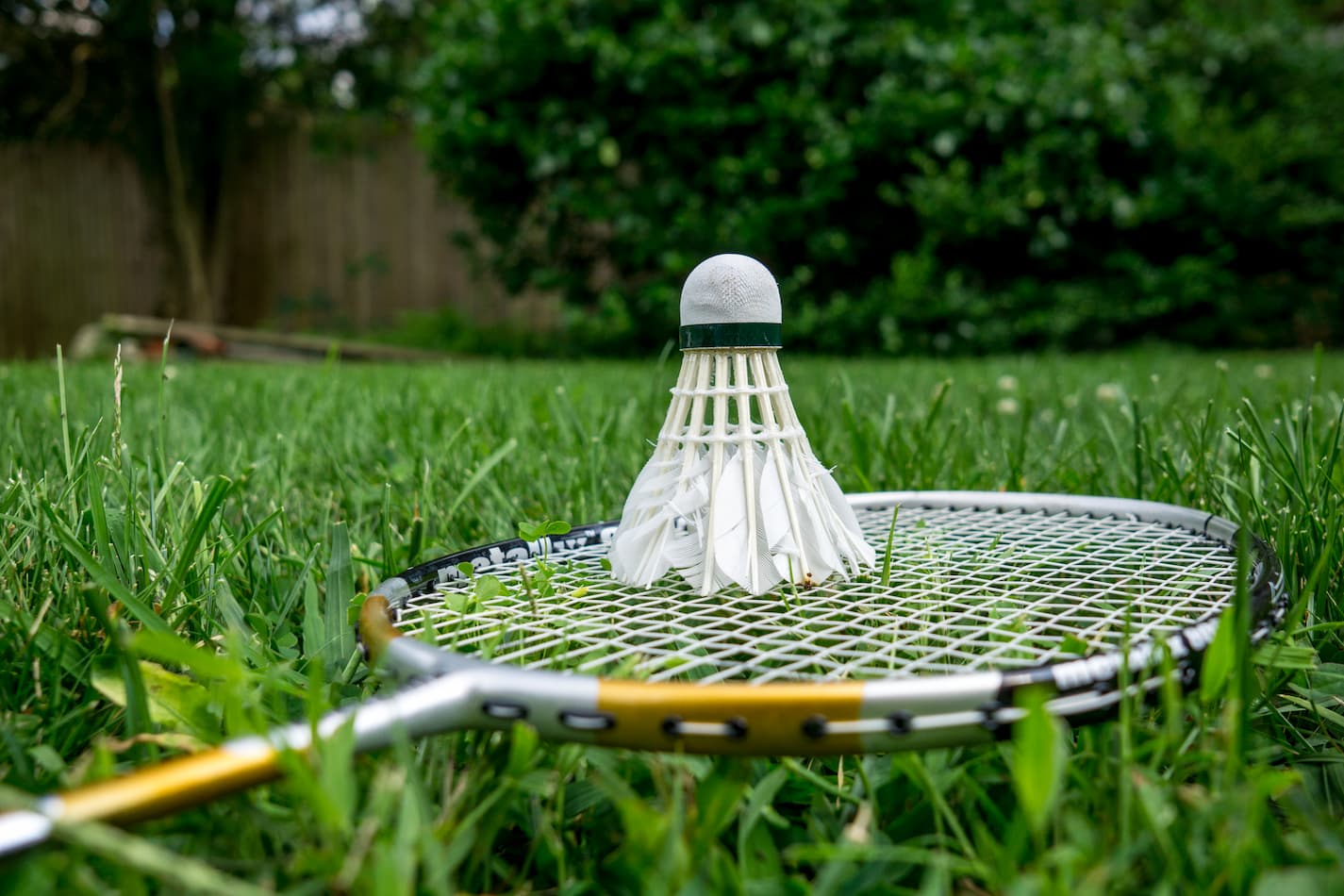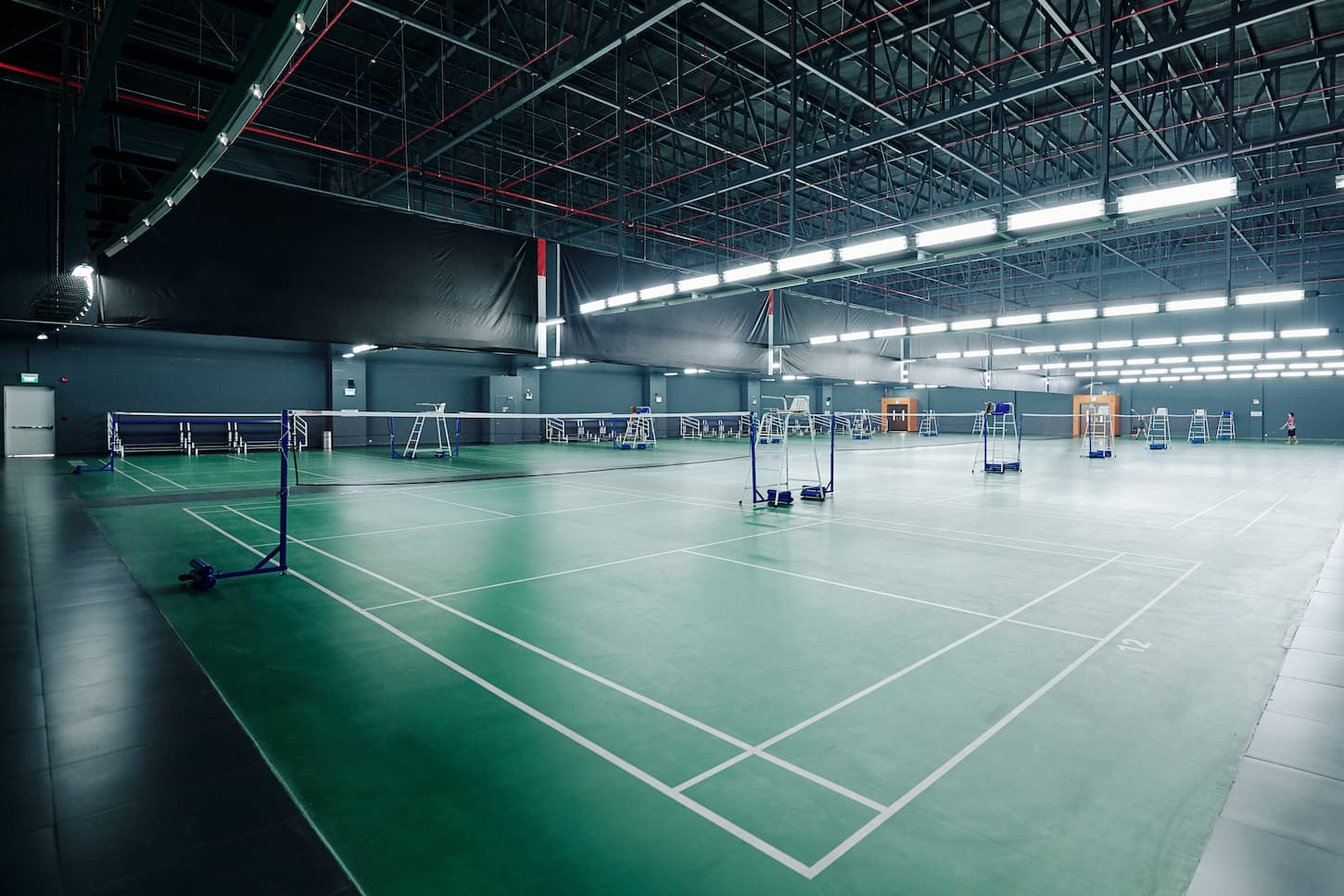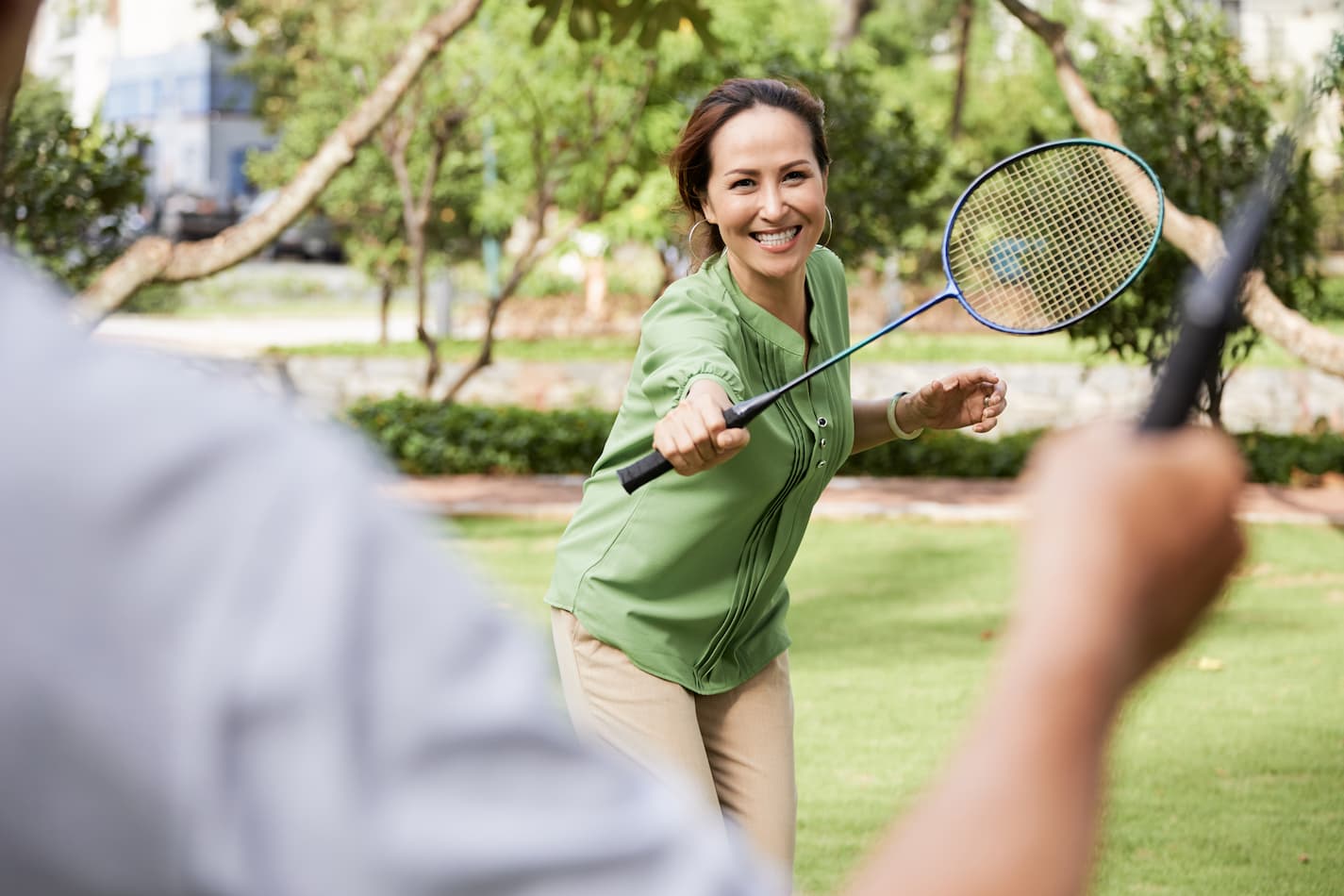Badminton is a racket-based sport – and a lot of fun! It’s the fastest sport in this category, and the shuttles can travel at a speed of 200 mph! Badminton is played at a quick pace that is exciting to both the players and the spectators. Agility and precise moves are needed to win this game.
The badminton equipment needed to play remains the same whether you play professionally or in your backyard, but the quality of equipment may vary.
Primary Equipment is required for playing badminton anywhere.
- Badminton Court or playable area
- Badminton Net
- Racquet
- Shuttlecock or Birdie
Secondary Equipment is more flexible, depending on where you’re playing. Secondary equipment focuses on clothing.
- Badminton attire
- Badminton shoes
Here is the equipment that you will need to play this game.

What Badminton Equipment Do You Need to Play a Game in the Backyard?
Playing badminton in the backyard requires the minimum: rackets, a shuttlecock (or birdie), and a playable area. Having a net makes backyard games better, but it isn’t required, as players can make do with some other barrier.
Badminton equipment is lightweight, which is nice. The players need the ability to understand and make good use of the court the win. In the following sections, we will dig more deeply into the details of badminton equipment.
Want to know more about how much it costs to play badminton, including the gear? Read my article on Badminton Costs: How Much It Costs to Get Started.
Badminton Net
The badminton net is placed on the net line, which is drawn in the middle of the court. The net has dimensions of 20ft by 2.5ft and is fixed at a height of 5ft 1in.
The nets used in professional games are made from high-quality vinyl mesh, and they are expensive. However, if you’re playing in the backyard, nets made up of nylon will work just fine.
When playing, the person who serves the shuttle has to hit the shuttle across to the court to win a point. If your serve hits the net or lands outside the designated court area, then a point will be awarded to the opponent player.
If the player has an even number of scores then he/she will serve from the right side of the court. Otherwise, the player will serve from the left side of the court.
Don’t want to buy a net yet? Great. Hang a sheet on a clothesline or set a lawn chair on its side. Or set up a couple of chairs and hang a towel across them. Don’t let a lack of net stop you from playing!
Racquets
Badminton racquets have a flat and uniform surface of strings that are used to hit the shuttle. These strings are attached to a shaft and form either an oval head shape or an isometric-shaped racquet.
Badminton racquets are made from materials like aluminum or carbon fiber which makes them very lightweight. There are different qualities of racquets available to buy.
If you are a beginner or just want to play in the backyard then you can buy beginner badminton racquets, which are designed for all kinds of players.
However, if wanting to play badminton as a professional, then the following guidelines for buying a racquet should be considered.
According to the rules of the Badminton World Federation, the length of a racquet cannot be greater than 26.7 inches, and the surface should be 8 inches wide and 11 inches high.
Moreover, the width of the racquet should be limited to around 9 inches. The diameter of the strings should be in the range of 0.03 inches. Lastly, the combined weight of a racquet should be under 3.2 ounces.
Shuttlecock / Birdie
The shuttlecock, otherwise known as the birdie, is cone-shaped with a rubber nose. The birdie is struck using the racquet during a badminton game.
There are two types of shuttles – one is made from a bird feather, and the other is made from plastic. If wanting to play in your backyard, then go for the plastic shuttles, because they are less expensive and more durable. Birdies are used in professional competitions due to their superior speed.
The birdie has 16 feathers attached to the rubber cork at the bottom. These shuttles are normally made from goose feathers, and each feather should be at least 2 inches long. The tip of the feathers should be arranged so that they form a diameter of around 2.5 inches.
On the other hand, synthetic shuttles have a net-like structure that forms the cone. The material used to make plastic shuttles mimics the way feathers work. The base of the shuttle should be around 1 inch in diameter.
Finally, the total weight of the shuttle should be 0.15 to 0.20 ounces, otherwise, the shuttle will not work properly.
From personal experience, there should be more than one shuttle when playing this game, so that even if the dog chews one or gets lost, there will still be a shuttle to play with.
Now that we have discussed the required equipment, let’s talk about the badminton court. Although a proper court is not needed if playing in your backyard, it might be fun to have a professional-style court anyway.
In addition, if you are a professional player and the pandemic has forced you to practice at home, then this would be a great idea. But how would you do this?

What is the Right Size for a Badminton Court?
According to the rules defined by the Badminton World Federation (BWF), the standard length of a badminton court is 44 ft. for both single and doubles matches. The standard width is different for single and double courts. It is 17 ft. wide for singles and 20 ft. wide for doubles competitions.
The court is split into two equal halves, each 22 ft. long divided by the center net line. The two halves are split further vertically, limiting the area for service. In total, every badminton court has four service areas with dimensions of 13 ft. by 8.5ft.
As per the guidelines from BWF, two different service lines are marked to address the service rules. One is called the short service line, which is marked at 6.5 ft. from the net, and the other is called the long service line which is marked at 2.5 ft. from the baseline.
During singles match the service area is outside of the short service line, within the boundaries. If the service is outside this area, a point is given to the opposite player.
On the other hand, if a doubles match is in progress, the boundaries are beyond the short service line and within the long service line. In other words, the service area for doubles is shorter than the service area for singles.
The surface of the badminton court is made of synthetic mats that are placed on top of a wooden floor. This is to make sure that the players feel comfortable and do not slip and fall. However, if playing in your backyard it will be difficult to accomplish that.
If the backyard has a grassy surface, make sure to mow the lawn before marking boundaries. If it’s a sandy or hard surface, then remove any rocks so that they aren’t stepped on. Make sure to wear non-slip shoes – otherwise, in the heat of the game, you might slip and get hurt.

Which Equipment is NOT Needed at First?
When just starting out playing badminton, you don’t need proper badminton attire or shoes. Both these things are secondary requirements and even if you do not have them, you will still be able to enjoy the game.
Simply wear your usual clothes and shoes! There are some things to consider which we will discuss below.
Badminton Clothes
Badminton has no standard uniform unless the league requires it. This means badminton can be played wearing whatever feels the most comfortable. T-shirts and shorts would be fantastic for this sport, or any workout attire that is desired.
There are some measures that can be taken if you sweat a lot while playing sports. Wear clothes that are moisture-wicking (polyester). The main benefit of a polyester shirt is that the sweat will not stick to your body.
Moreover, polyester clothes do not wrinkle easily and are very durable and lightweight, which may give you an edge if you are playing in tough competition. Furthermore, polyester shirts dry quickly and maintain their structure for quite some time.
If you don’t have polyester clothes, then the other option is to take a spare pair of clothes with you when you go out to play.
Note: some badminton leagues and teams do require uniforms as my high school badminton team did.
Thankfully, the uniform was a classy set of polo shirts and khaki shorts, so it was pretty flexible while looking awesome.
Badminton Shoes
When choosing badminton shoes, you should consider two things. First, whether to play indoors or outdoors; and second, whether the shoes are marking or non-marking.
Most people wear their joggers to play badminton. However, if wearing joggers and playing on an indoor court then it is likely that you will be reprimanded. This is because the majority of joggers leave marks on the badminton court, so it is better to select shoes that are non-marking.
Some people wear tennis shoes to play badminton instead. This is also not a great idea since some tennis shoes also leave marks on the court.
Moreover, tennis shoes are designed to help the players make quick horizontal movements, but in badminton, there is more vertical movement than horizontal so tennis shoes might not be best for lunging and jumping – the key aspects of badminton.
It doesn’t mean tennis shoes won’t work for badminton, just that they may be overkill if they’re super-nice tennis shoes.
The second thing to consider is the surrounding in which you are playing. Using the same shoes that you use indoors for outdoor games is also not a good idea.
There will be different court surfaces when playing indoors vs. outdoors. As mentioned before, the indoor courts have a wooden surface with synthetic mats whereas the outdoor surface depends on where you are playing.
This is important because it is possible that a pair of shoes with a particular sole design might be perfect for indoor games – but the same shoes might not work well in an outdoor setting.
Moreover, indoor shoes would easily get damaged and worn out if used outdoors. So, be mindful of these things when buying shoes to avoid any mishaps.
Now that we know about the equipment and the court designs, let’s briefly discuss the basics of badminton.

Basics of Badminton
To start, one player is on each side of the net for singles, and two players are on each side in the doubles match. The game has 3 sets, and the team that takes 2 sets wins. To win a set, the player scores 21 points. If both teams score 20 points, then the side that scores 2 consecutive points wins.
Each side of the court has a left serving box and a right serving box. At the start of each set, the server stands in the right serving box and the receiver stands in the left box on the other side of the court. A point is earned when the shuttle touches the ground in the opponent’s area.
Want to change things up with badminton? Here are Badminton Alternatives: 13 Other Games You’ll Love. We may have had fun writing that, so hopefully it gives you some great ideas on variations you can play!
Key Takeaways and Next Steps
Hopefully, in reading this article, you have discovered how much fun badminton is, and that it can be played either professionally at a proper court, or in your own backyard with family and friends. I have good memories of playing this game with my family, and you can create some fun memories too!
All that is needed is the right amount of space, a net, racquets, and the shuttlecock/birdie. Clothing can range from professional logo-style t-shirts and shorts to whatever you feel comfortable playing in – especially at home.
For further information about the costs of playing badminton, read my article on Badminton Costs: How Much It Costs to Get Started. It really doesn’t have to be expensive, especially if you get a badminton playing kit!

Resources
Learning from your own experiences is important, but learning from others is also smart. These are the sources used in this article and our research to be more informed as a family of sports nuts wannabes.
- “Official Badminton Net Height.” Sportsrec, 2021, www.sportsrec.com/5162216/official-badminton-net-height.
- “Badminton Equipment List”. Rookieroad.Com, 2021, https://www.rookieroad.com/badminton/equipment-list/.
- Peter, Naveen. “Badminton Court: Markings, Size And All You Need To Know”. Olympics.Com, 2021, https://olympics.com/en/featured-news/badminton-court-size-dimension-measurement-length-width-net-height-service-line.
- “Standard Length & Width Of A Shuttle Court”. Sportsrec, 2021, https://www.sportsrec.com/standard-length-width-shuttle-court-11399103.html.
- “What Equipment Do You Need To Play Badminton? – Badmintonbites”. Badmintonbites, 2021, https://badmintonbites.com/what-equipment-do-you-need-to-play-badminton/.
